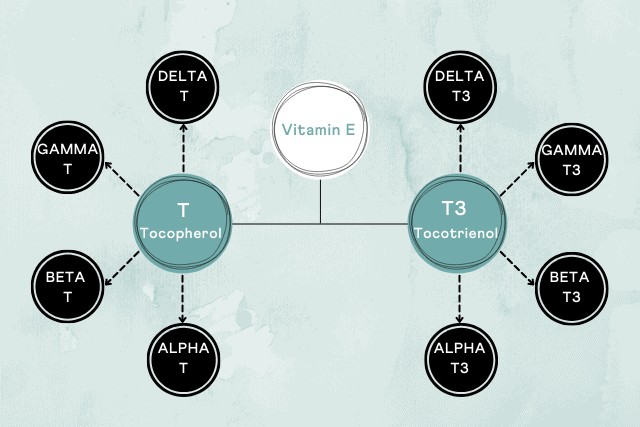Vitamin E is a group of 8 different nutrient compounds: 4 types of tocopherols and four types of tocotrienols. Both tocopherols and tocotrienols are types of vitamin E nutrients.
Image: Forms of Vitamin E
The most predominant form of vitamin E in the body is α-tocopherol. It comprises over 90% of the vitamin E found in the body. This form was first isolated from wheat germ oil. Interestingly, the “tokos” in α-tocopherol stands for “childbirth.”
Animal studies have revealed that a deficiency of α-tocopherol increases the risk of infertility. That’s why this nutrient is also known as anti-infertility vitamin or anti-sterility factor X.
Food Sources of Vitamin E
Vitamin E is an essential nutrient, which means we need to obtain this nutrient through food sources.
Some foods rich in vitamin E are almonds, sunflower seeds, avocados, peanut butter, pine nuts, rainbow trout, and pumpkin.
Benefits of Vitamin E
Vitamin E is a potent antioxidant and protects our body from the damaging effects of free radicals.
Free radicals are unstable molecules that are harmful to the healthy cells in our bodies.
Vitamin E also has anti-aging properties.
Absorption and Metabolism of Vitamin E
Once vitamin E enters the body, it is absorbed by the intestines and stored in the adipose tissues, commonly known as body fat. On-demand, the adipose tissues are broken down to release vitamin E.
Here, it is important to know that the liver only acts on α-tocopherol and converts it into a form that is usable by the cells in the body. All other types of vitamin E are excreted out.
Vitamin E Deficiency
A healthy adult woman requires about 8 mg of vitamin E per day. In men and pregnant women, the requirement increases to 10 mg per day.
Vitamin E deficiency can result in a weakened immune system, muscle damage, vision loss, and nervous system-related disorders.
Many conditions like cystic fibrosis, short bowel syndrome, and chronic pancreatitis prevent effective absorption of fats, including the fat-soluble vitamin E. So, they can increase your risk for vitamin E deficiency.
Genetics of Vitamin E Deficiency
Genetics is another important factor that contributes to vitamin E deficiency.
The TTPA gene is crucial for regulating vitamin E levels in the body. It contains instructions for the production of α-tocopherol transfer protein. This protein is responsible for the distribution of vitamin E obtained from the diet to all the cells and tissues of the body.
Any changes in this gene can affect the amount of the protein produced, and hence the vitamin E levels. People who have these changes are at a higher risk of vitamin E deficiency.
Getting a Genetic Test
A simple genetic test can reveal your genetic status of vitamin E deficiency.
Most genetic tests provide your DNA information in the form of a text file called the raw DNA data. This data may seem like Greek and Latin to you.
At Xcode Life, can help you interpret this data. Upload your raw data and order a nutrition report.
Xcode Life then analyzes your raw data in detail to provide you with comprehensive nutrition analysis, including information on your vitamin E requirements.
Also Check Out: Gene Nutrition Report Walkthrough!





